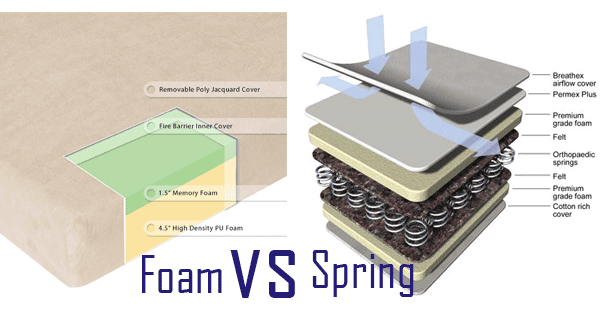[wp_ad_camp_1]
Last Updated: August 2017
One of the greatest debates in the mattress industry today is that of the memory foam vs spring mattresses. Before deciding that one must be better than the other, it is important to take a look at the benefits and downfalls of each. In the end, there is no denying that memory foam is almost always the better choice.
Memory Foam Mattresses
Memory foam mattresses come with a huge list of advantages that innerspring mattresses just do not have.
- More choice – Because there are so many different technologies available to memory foam mattress manufacturers these days, the consumer has more choice in terms of firmness, conformability, and support.
- Pain relief – When comparing a foam vs. spring mattress, a foam mattress will always provide more conformability. Because of this, those who choose to sleep on foam mattresses experience far less back and neck pain than those who choose innerspring mattresses.
- Better contour – A foam mattress is the equivalent of millions upon millions of tiny little springs. This means that it will conform and contour to your body much better, giving you optimal support – regardless of your body size or shape.
- Longer lifespan – A foam mattress will last much longer than an innerspring mattress because of the high quality of the materials used. Because an innerspring mattress has moving parts that can fail over time, a memory foam mattress will keep you more comfortable over many more years without sag or broken springs.
Of course, foam mattress owners also have a few complaints from time to time. The good news is that for every complaint, there is a valid solution.
- Heat – It is true that foam traps more body heat than the materials used for innerspring mattresses. However, thanks to new technologies, you can purchase mattresses with an outer layer of cooling gel that will keep you comfortable all night long.
- The wait to use the mattress – If your memory foam mattress is shipped to you, you might need to give it some time to fully expand before you can use it. What’s more, many foam mattresses give off an odor for the first few weeks after they are unpackaged. Many users do not notice the odor, and those who do claim that it dissipates quickly after removing the packaging.
- The expense – Memory foam mattresses are more expensive than their innerspring counterparts. However, they do last longer if you care for them properly, and they offer a priceless amount of comfort and pain relief.
Innerspring Mattresses
[wp_ad_camp_1]
When looking at spring vs. foam mattresses, it is also important to consider the benefits that innerspring mattresses may be able to offer you.
- Affordability – Innerspring mattresses are almost always cheaper than their foam counterparts, and the reason for this is simple. The technology in an innerspring mattress is incredibly basic, and the parts used to make them are cheap for the manufacturer.
- Instant gratification – You can use an innerspring mattress as soon as you receive it because it is already at its optimal shape.
- Ventilation – Innerspring mattresses will not heat up as you sleep thanks to their basic but effective ventilation.
In almost every case, however, these few advantages are overtaken by the sheer number of drawbacks. In consumer polls, more people dislike their innerspring mattresses than their foam mattresses, and for good reasons.
- Pain – The inside of an innerspring mattress contains large metal coils that are supposed to support your body as you sleep. Unfortunately, these coils push back on your body with the same force that your body pushes on them, which ultimately gives you very little support or conformability, regardless of the firmness.
- Poor weight distribution – No innerspring mattress in the world today can distribute your body weight as evenly as a foam mattress. This means that your spine will not be perfectly aligned on a spring mattress, and this can lead to pain.
- Short warranty – The materials used in innerspring mattresses cannot hold up to years and years of use. For this reason, most manufacturers will never offer more than 10-year warranty because sagging and other problems are inevitable due to design.
- High maintenance – In order to expand the life of your innerspring mattress, you not only have to rotate it in order to relieve the pressure on the springs, but you also have to flip it over – and you have to do it often. This is not necessary with memory foam.
In the end, when comparing memory foam vs. spring mattresses, there is absolutely no doubt that memory foam is the better choice. You can purchase it in a variety of densities in order to suit your needs and preferences, and although it is a larger initial investment, you will get more out of it in the long run in terms of both longevity and a better night’s sleep.

